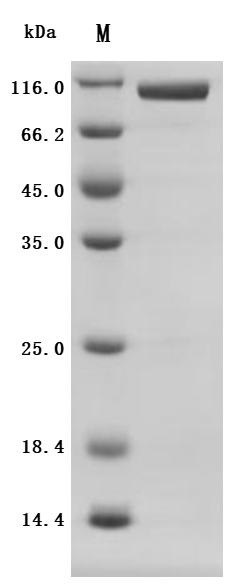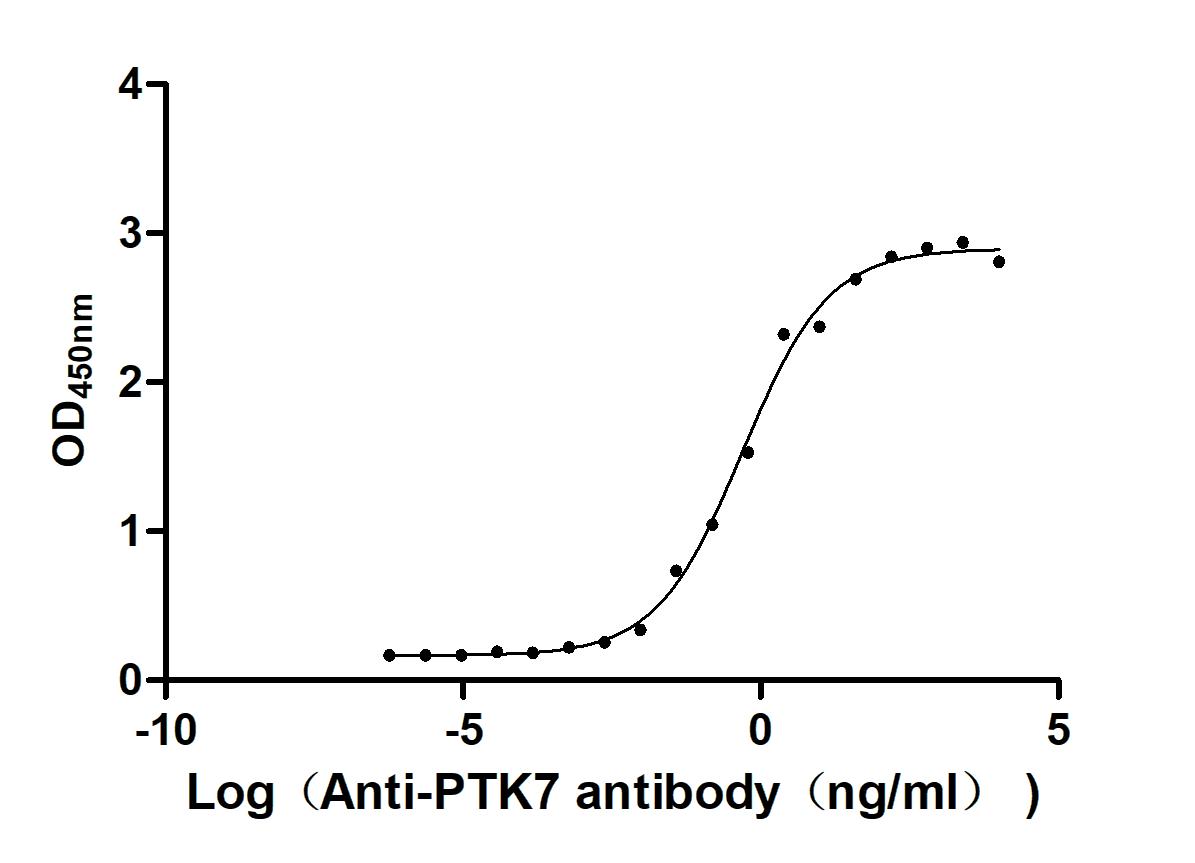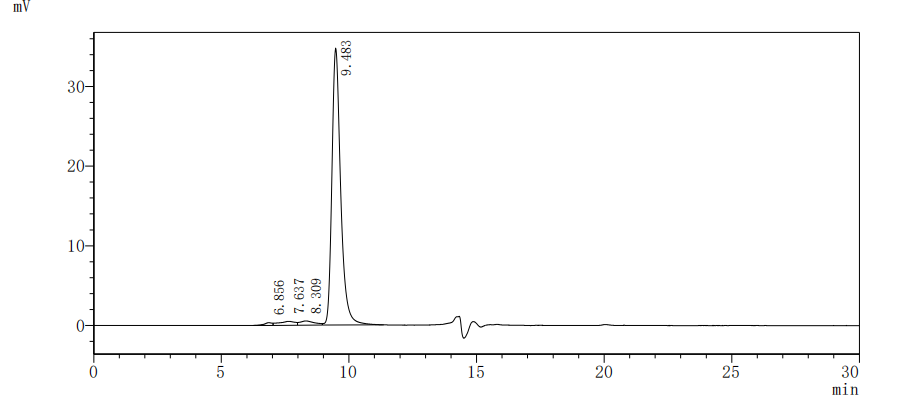The recombinant human PTK7 protein is expressed in mammalian cells. Its production starts with the design and construction of recombinant DNA vectors to express the PTK7 protein (31-704aa) fused with the C-terminal 10xHis-tag. These assembled vectors are then transformed into a mammalian cell line to produce recombinant PTK7 proteins. The recombinant PTK7 protein purification is performed via immobilized metal affinity chromatography (IMAC) thanks to the 10×His-tag. Its purity is greater than 95% measured by both SDS-PAGE and SEC-HPLC. Its endotoxin level is less than 1.0 EU/ug as determined by the LAL method. In a functional ELISA, the recombinant PTK7 protein is validated to be biologically active as immobilized PTK can bind to anti-PTK7 recombinant antibody (CSB-RA622651MA1HU) with the EC50 of 0.3675 - 0.65842 ng/mL.
Human PTK7, also known as colon carcinoma kinase-4 (CCK-4), is an inactive receptor tyrosine kinase containing an extracellular domain with seven immunoglobulin-like loops, a transmembrane domain, and a kinase domain that lacks catalytic activity [1]. Different from other members of the receptor tyrosine kinase family, PTK7 does not exhibit traditional kinase activity [2].
PTK7 has been shown to interact with the Wnt signaling pathway, specifically inhibiting canonical Wnt signaling while promoting non-canonical Wnt/planar cell polarity (PCP) signaling [3][4]. This dual role is critical during vertebrate development, influencing processes such as neural crest migration and morphogenesis [4]. The interaction of PTK7 with Wnt proteins, particularly Wnt5a, has been implicated in enhancing cell migration and influencing cellular behaviors associated with cancer progression [5].
PTK7 is linked to various malignancies, including esophageal squamous cell carcinoma (ESCC), colorectal cancer, and lung cancer [6][7], and high levels of PTK7 expression is correlated with poor prognosis in these cancers [8]. PTK7 has been associated with promoting invasive phenotypes in cancer cells through mechanisms involving matrix metalloproteinase-9 (MMP-9) and activation of transcription factors such as AP-1 and NF-κB [8]. Furthermore, therapeutic strategies targeting PTK7, such as antibody-drug conjugates, have shown promise in reducing tumor-initiating cells and inducing tumor regressions, highlighting its potential as a therapeutic target [9].
References:
[1] W. Shin, M. Park, J. Kim, S. Oh, J. Jang, H. Lee, et al. Ptk7, a catalytically inactive receptor tyrosine kinase, increases oncogenic phenotypes in xenograft tumors of esophageal squamous cell carcinoma kyse-30 cells, International Journal of Molecular Sciences, vol. 23, no. 4, p. 2391, 2022. https://doi.org/10.3390/ijms23042391
[2] R. Gobble, L. Qin, E. Brill, C. Angeles, S. Ugras, R. O’Connor, et al. Expression profiling of liposarcoma yields a multigene predictor of patient outcome and identifies genes that contribute to liposarcomagenesis, Cancer Research, vol. 71, no. 7, p. 2697-2705, 2011. https://doi.org/10.1158/0008-5472.can-10-3588
[3] A. Andreeva, J. Lee, M. Lohia, X. Wu, I. Macara, & X. Lu. Ptk7-src signaling at epithelial cell contacts mediates spatial organization of actomyosin and planar cell polarity, Developmental Cell, vol. 29, no. 1, p. 20-33, 2014. https://doi.org/10.1016/j.devcel.2014.02.008
[4] M. Hayes, M. Naito, A. Daulat, S. Angers, & B. Ciruna. Ptk7 promotes non-canonical wnt/pcp-mediated morphogenesis and inhibits wnt/β-catenin-dependent cell fate decisions during vertebrate development, Development, vol. 140, no. 8, p. 1807-1818, 2013. https://doi.org/10.1242/dev.090183
[5] L. Qiu. Elucidating the functional mechanism of ptk7 in cancer development through spatial assembly analysis using super resolution imaging, Analytical Chemistry, vol. 96, no. 19, p. 7669-7678, 2024. https://doi.org/10.1021/acs.analchem.4c00588
[6] S. Chen, Y. Wang, Y. Su, L. Zhang, M. Zhang, X. Li, et al. Mir‑205‑5p/ptk7 axis is involved in the proliferation, migration and invasion of colorectal cancer cells, Molecular Medicine Reports, 2018. https://doi.org/10.3892/mmr.2018.8650
[7] J. Kim, J. Kwon, H. Lee, M. Kang, H. Yoon, S. Lee, et al. Protein tyrosine kinase 7 plays a tumor suppressor role by inhibiting erk and akt phosphorylation in lung cancer, Oncology Reports, vol. 31, no. 6, p. 2708-2712, 2014. https://doi.org/10.3892/or.2014.3164
[8] W. Shin, Y. Hong, H. Lee, & S. Lee. Catalytically defective receptor protein tyrosine kinase ptk7 enhances invasive phenotype by inducing mmp-9 through activation of ap-1 and nf-κb in esophageal squamous cell carcinoma cells, Oncotarget, vol. 7, no. 45, p. 73242-73256, 2016. https://doi.org/10.18632/oncotarget.12303
[9] M. Damelin, A. Bankovich, J. Bernstein, J. Lucas, L. Chen, S. Williams, et al. A ptk7-targeted antibody-drug conjugate reduces tumor-initiating cells and induces sustained tumor regressions, Science Translational Medicine, vol. 9, no. 372, 2017. https://doi.org/10.1126/scitranslmed.aag2611






